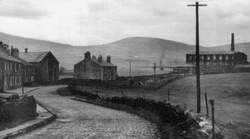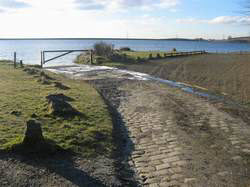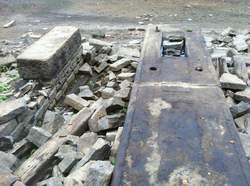Abandoned Communities ..... Rochdale Reservoirs
The Watergrove reservoir is about two miles east of Cowm. To get to it you can either walk over the moor from Whitworth or else travel into Rochdale and then out on the road through the village of Wardle. It was constructed in the 1930s, partly with the aim of providing jobs during a period of high unemployment, but mainly because the water requirements of Rochdale had become increasingly urgent. It is the largest reservoir supplying water to Rochdale. The opening ceremony took place on 6 April 1938.
There was a small village called Watergrove, now submerged under the reservoir, and scattered around the valley were about thirty farms, some of which had a few cottages close to them. In the nineteenth century the population reached about 300, but it had started to decline before the reservoir was built. It was about 250 at the turn of the century and about 200 in the 1920s. The Water Board insisted that nearly everyone should move out, including people living above the water line.
The village of Watergrove developed in the 1840s, and was completed within 20 years. Most of the houses were located along the west side of the main street, Ramsden Road. Watergrove Farm would have been the first house you passed, and three cottages were attached to it. Soon you would come to the Orchard public house, and next to it a block of six back-to-back cottages. There was a Methodist church, and then a side road led to a terrace of houses known as Bowers Row. Next on Ramsden Road there was another block of six back-to-back cottages. A little further along the road on the right stood Watergrove Mill.
This description of Watergrove village is based on information in Allen Holt's book, Watergrove: A History of the Valley and its Drowned Village, published by Geoge Kelsall in 2002. I have relied on the same book for much of my other information on Watergrove.
It appears that the village came into existence to provide accommodation for workers at Watergrove Mill. A small mill for weaving woollen cloth was built in 1841, but there was substantial expansion in 1851 when Mary Clayton took over and started to produce cotton goods. She employed 40 staff. That mill was replaced by a larger steam-powered mill in 1879.
Watergrove Mill continued in operation until the building of the reservoir. It was then converted for use by the Water Board, with workshops on the ground floor, offices on the first floor, and a canteen on the second floor.
The mill was demolished before Watergrove was flooded, but during prolonged dry weather part of its foundations, a flagstone floor, and a section of railway line come into view.
Another mill, Roads Mill, occupied a site north west of the village, on Higher Slack Brook. When the reservoir was planned the owners of Roads Mill, Slater & Co., dismantled as much machinery and equipment as possible and re-opened the business six miles away at Wicken Hall Mill, Lower Ogden.
The site of Roads Mill is usually submerged under the north western arm of Watergrove Reservoir, but the two photographs at the foot of the page, taken in July 2013, show some of the remnants that may appear after dry weather.
The Methodist church in Watergrove opened in 1852, but there had been a strong tradition of Methodism in the valley since 1744, when William Darney preached in a barn at Higher Dobbin Farm.
William Darney has also been mentioned in the section of this website on Wycoller.
A Wesleyan Methodist Association was formed in the valley in 1835, with meetings and services being held at Higher Dobbin Farm, Marled Earth Farm, and in a house in Bowers Row. After the church opened it became a centre for social events and organised excursions as well as religious services. The Whit Saturday Choir Trips would often take the form of a very long day out with railway journeys to Edinburgh, London, or Windermere.
The last service at the Methodist church took place on Sunday 23 July, 1933. The final hymn, with Mr H Sykes on the organ, was God Be With You Till We Meet Again.
The history of Methodism at Watergrove and more details about the last few events in the church before it closed appear in an article in the Rochdale Observer 1 December, 1976. The words and music of God Be With You Till We Meet Again can be found on the HymnSite website.
There was a small village called Watergrove, now submerged under the reservoir, and scattered around the valley were about thirty farms, some of which had a few cottages close to them. In the nineteenth century the population reached about 300, but it had started to decline before the reservoir was built. It was about 250 at the turn of the century and about 200 in the 1920s. The Water Board insisted that nearly everyone should move out, including people living above the water line.
The village of Watergrove developed in the 1840s, and was completed within 20 years. Most of the houses were located along the west side of the main street, Ramsden Road. Watergrove Farm would have been the first house you passed, and three cottages were attached to it. Soon you would come to the Orchard public house, and next to it a block of six back-
This description of Watergrove village is based on information in Allen Holt's book, Watergrove: A History of the Valley and its Drowned Village, published by Geoge Kelsall in 2002. I have relied on the same book for much of my other information on Watergrove.
It appears that the village came into existence to provide accommodation for workers at Watergrove Mill. A small mill for weaving woollen cloth was built in 1841, but there was substantial expansion in 1851 when Mary Clayton took over and started to produce cotton goods. She employed 40 staff. That mill was replaced by a larger steam-
Watergrove Mill continued in operation until the building of the reservoir. It was then converted for use by the Water Board, with workshops on the ground floor, offices on the first floor, and a canteen on the second floor.
The mill was demolished before Watergrove was flooded, but during prolonged dry weather part of its foundations, a flagstone floor, and a section of railway line come into view.
Another mill, Roads Mill, occupied a site north west of the village, on Higher Slack Brook. When the reservoir was planned the owners of Roads Mill, Slater & Co., dismantled as much machinery and equipment as possible and re-
The site of Roads Mill is usually submerged under the north western arm of Watergrove Reservoir, but the two photographs at the foot of the page, taken in July 2013, show some of the remnants that may appear after dry weather.
The Methodist church in Watergrove opened in 1852, but there had been a strong tradition of Methodism in the valley since 1744, when William Darney preached in a barn at Higher Dobbin Farm.
William Darney has also been mentioned in the section of this website on Wycoller.
A Wesleyan Methodist Association was formed in the valley in 1835, with meetings and services being held at Higher Dobbin Farm, Marled Earth Farm, and in a house in Bowers Row. After the church opened it became a centre for social events and organised excursions as well as religious services. The Whit Saturday Choir Trips would often take the form of a very long day out with railway journeys to Edinburgh, London, or Windermere.
The last service at the Methodist church took place on Sunday 23 July, 1933. The final hymn, with Mr H Sykes on the organ, was God Be With You Till We Meet Again.
The history of Methodism at Watergrove and more details about the last few events in the church before it closed appear in an article in the Rochdale Observer 1 December, 1976. The words and music of God Be With You Till We Meet Again can be found on the HymnSite website.
Three
Part of the village of Watergrove, with Watergrove Mill in the distance on the right
1890s map showing Watergrove village and the surrounding area.
Watergrove Reservoir in January 2011. The red buoy marks the location of the village.
Ramsden Road as it emerges on the north side of Watergrove Reservoir
Remains of the mill lodges at Roads MIll
The engine base at Roads Mill
These two photographs were taken by Helen Percy in July 2013





